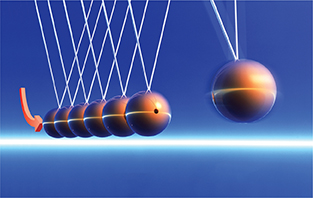16.2 Heat and Thermodynamics
Reading Focus
Key Concepts
 Why is conduction slower in gases than in liquids or solids?
Why is conduction slower in gases than in liquids or solids? In what natural cycles do convection currents occur?
In what natural cycles do convection currents occur? How does an object's temperature affect radiation?
How does an object's temperature affect radiation? What are the three laws of thermodynamics?
What are the three laws of thermodynamics?
Vocabulary
conduction
thermal conductor
thermal insulator
convection
convection current
radiation
thermodynamics
heat engine
waste heat
Reading Strategy
Building Vocabulary Copy the table below. As you read, add definitions and examples to complete the table.
Definitions |
Examples |
|---|---|
Conduction: transfer of thermal energy without transfer of matter |
Frying pan handle heats up. |
Convection: a. |
b. |
Radiation: c. |
d. |
To bake cookies, you put cookie dough on a baking sheet and pop it in the oven. When the timer goes off, you use oven mitts to pull out the baking sheet. Why isn't your bare arm burned by the hot air in the oven? One reason is that air is not a very good conductor of thermal energy.
Conduction
Conduction is the transfer of thermal energy with no overall transfer of matter. Conduction occurs within a material or between materials that are touching. To understand conduction, look at the Newton's cradle in Figure 5. When a ball is pulled back and released, you might expect all of the balls to move to the right after the impact. Instead, most of the kinetic energy is transferred to one ball on the end. Similarly, in conduction, collisions between particles transfer thermal energy, without any overall transfer of matter.
Recall that forces are weak among particles in a gas. Compared to liquids and solids, the particles in gases are farther apart.  Conduction in gases is slower than in liquids and solids because the particles in a gas collide less often. In most solids, conduction occurs as particles vibrate in place and push on each other. In metals, conduction is faster because some electrons are free to move about. These free electrons collide with one another and with atoms or ions to transfer thermal energy.
Conduction in gases is slower than in liquids and solids because the particles in a gas collide less often. In most solids, conduction occurs as particles vibrate in place and push on each other. In metals, conduction is faster because some electrons are free to move about. These free electrons collide with one another and with atoms or ions to transfer thermal energy.

Figure 5 Conduction is the transfer of thermal energy without transferring matter. This device, called Newton's cradle, helps to visualize conduction. After one ball strikes the rest, most of the kinetic energy is transferred to one ball on the end.





